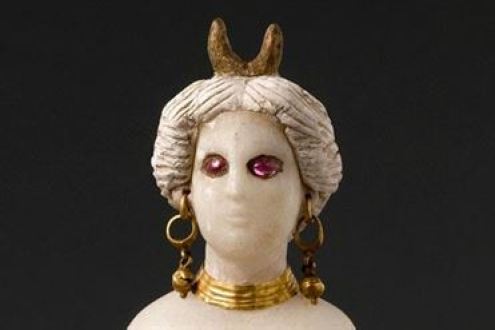Statuette of nude goddess
1st c BC
From Mesopotamia
Rubies from Burma
Probably Ishtar



( it’s on loan From Louvre & their description reads:
A figurine discovered in a tomb
This alabaster statuette, discovered in 1862 by Pacifique-Henri Delaporte, the French consul in Bagdad, comes from a tomb dating from the Parthian period. This period marked the start of an Indo-European dynasty of Iranian origin which, supplanting the Greek Seleucid kingdom, extended its dominion from the Iranian plateau to Mesopotamia. It brought with it a civilization with both Near Eastern and Greek heritage. The family tomb in which this statuette was found was a funerary chamber containing five tombs. The figurine was found upright in one of these tombs, near the head of the body, laid in a wooden coffin.
A Greco-Oriental style
This gracefully modeled alabaster statuette depicts a naked woman, standing with her right arm against her body and her left arm bent, palm raised. She wears a stucco headdress topped with a gilded crescent. Her eyes are set with rubies. She has a small mouth and a rounded chin, and pierced ears decorated with gold pendants. She is wearing a gold necklace. Her high breasts are well shaped. The arms are articulated and attached with a thread, no doubt originally a gold wire. The woman has a slim waist and broad curving hips, and wears a ruby in her navel. Her thighs and legs are close together. Although the modeling is consistent with the canons of Greek art, the use of several materials such as gold, stucco, alabaster, and precious stones is a truly Mesopotamian tradition. Ishtar, the Babylonian goddess of sexuality and war, has taken on Greek attributes and metamorphosed into Aphrodite.
https://www.louvre.fr/en/oeuvre-notices/standing-nude-statuette-goddess
